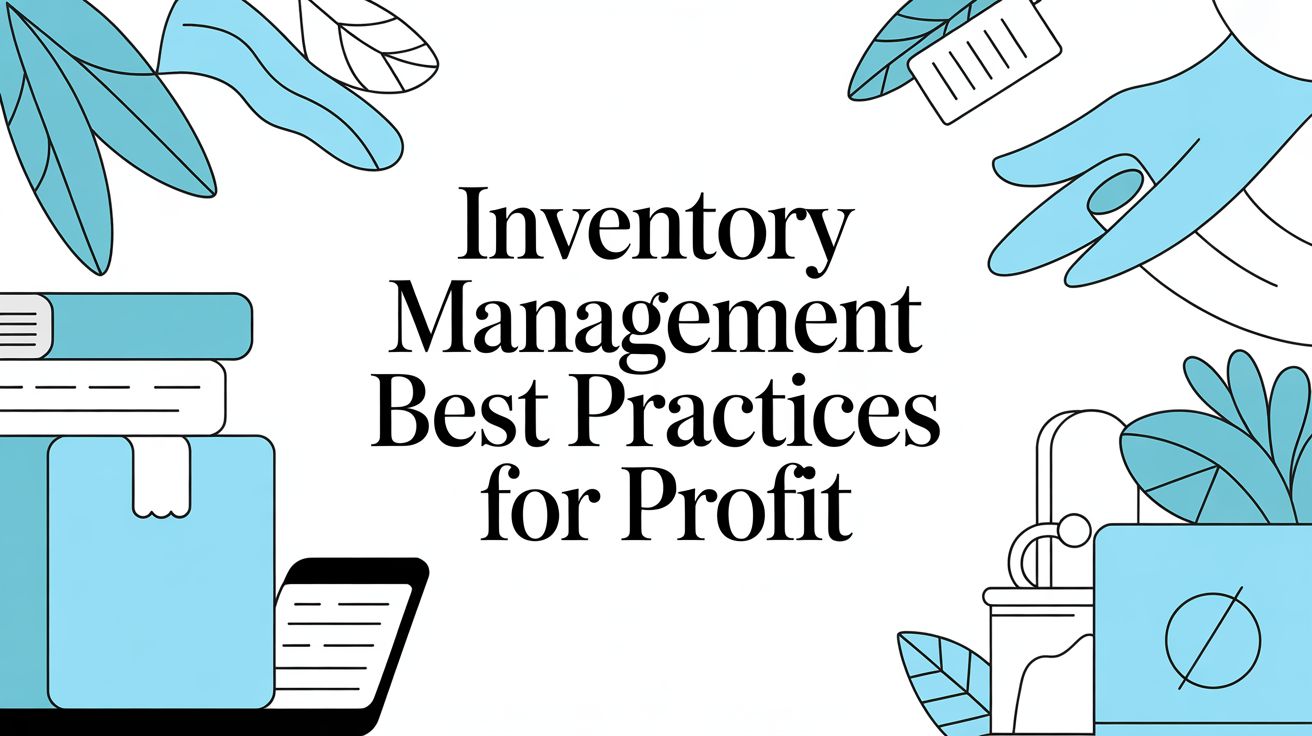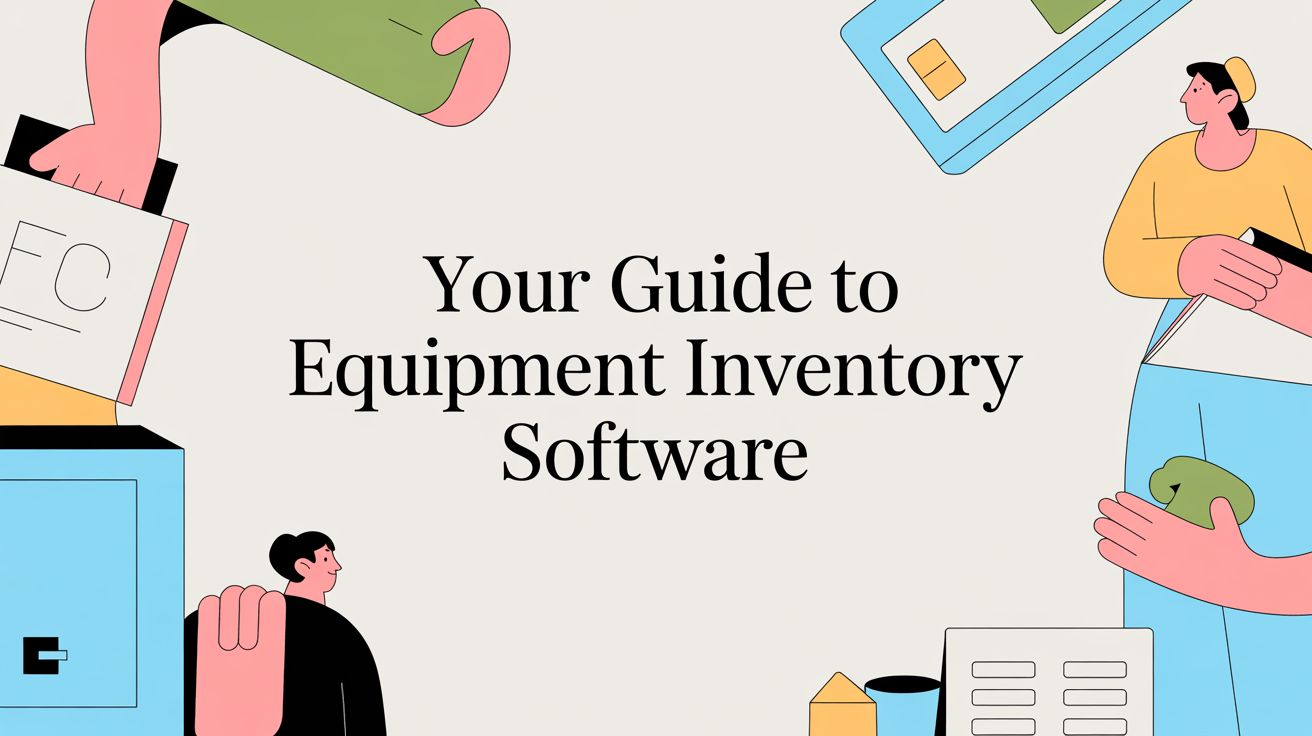At its heart, inventory management is all about balance. It’s the strategic game of sourcing, storing, and selling your stuff, whether that's for a business or your own home. The goal is simple but crucial: have the right products in the right place at the right time. Get it right, and you avoid costly overstock situations and frustrating shortages that kill sales and create stress.
This balance is the key to financial health and happy customers.
Why Smart Inventory Management Is Your Secret Weapon

Inventory management is so much more than just counting boxes on a shelf. It's the engine that powers a business's operational efficiency and financial well-being. Think of it like a professional kitchen running dinner service. Too few ingredients, and you can’t make the dishes your customers want. Too many, and valuable food spoils, wasting money and precious space.
When you master this delicate balance, it directly impacts your cash flow, customer loyalty, and ultimately, your bottom line. It transforms your inventory from a passive cost into a powerful competitive advantage.
The Hidden Costs of Poor Inventory Control
When inventory is poorly managed, the consequences ripple through the entire operation. Overstocking ties up your capital in unsold goods, drives up storage and insurance costs, and risks products becoming obsolete or expiring. That's cash that could be invested in marketing, product development, or anywhere else.
On the other hand, understocking is just as dangerous. It leads directly to lost sales and disappointed customers who might just turn to a competitor and never come back. If you consistently fail to meet demand, you can permanently damage your brand's reputation, making it incredibly difficult to win back trust.
These problems highlight why you need a proactive strategy. Instead of constantly reacting to stock emergencies, a well-planned system helps you anticipate needs and make informed decisions. This is where putting proven inventory management best practices into place becomes absolutely essential. These practices help businesses achieve:
- Improved Cash Flow: By freeing up capital that would otherwise be trapped in excess stock.
- Enhanced Customer Satisfaction: By ensuring your most popular products are always available.
- Reduced Operational Costs: Through lower storage fees and less product waste.
- Greater Business Agility: By making it easier to respond to market changes and shifts in demand.
Embracing a Modern Approach
The shift toward smarter inventory control is a massive business trend. In fact, the global inventory optimization market is projected to grow from USD 5.87 billion in 2025 to a staggering USD 12.42 billion by 2032. This growth isn't random; it's fueled by the adoption of real-time data analytics and cloud-based platforms that give businesses a crystal-clear view into their stock levels. You can dig into the specifics on these market trends in recent industry reports.
By moving from a reactive "firefighting" mode to a proactive, data-driven strategy, you can turn your inventory into one of your most valuable assets, ensuring long-term stability and growth.
This guide will give you the concrete best practices you need to build that strategy, turning chaotic stockrooms into streamlined, profitable operations.
Mastering Core Inventory Control Techniques
To really get a handle on your stock, you need more than just shelves and boxes. You need a toolkit of proven inventory control techniques. These methods are the bedrock of smart inventory management, shifting you from just storing items to strategically managing them. They bring structure and logic to your operations, helping you make smarter calls on what to prioritize, when to reorder, and how to move your products.
Think of these techniques as different plays in a coach's playbook. Each one is designed for a specific situation, but when you use them together, you create a winning strategy.
Prioritize with ABC Analysis
Let's be honest: not all of your inventory is created equal. Some items are superstars, while others are just benchwarmers. ABC analysis is a powerhouse method for sorting your items based on their actual value to your business. It works by bucketing products into three simple tiers, so you can focus your energy where it really counts.
- A-Items: These are your most valuable products. They typically make up a staggering 80% of your inventory value but only 20% of your total stock. These items need your full attention, so close monitoring, frequent counts, and careful demand forecasting are non-negotiable.
- B-Items: This is your solid middle ground. These items are moderately valuable and need less hand-holding than your A-list products, but more attention than the C-listers.
- C-Items: These are the low-value items that make up the bulk of your physical inventory but don't contribute much to the bottom line. You can manage these with simpler controls and count them less often.
By applying this method, you stop treating every screw and every server the same way. You start investing your time and money where you'll see the biggest return.
Set Par Levels to Avoid Stockouts
A par level is simply the minimum amount of an item you need on hand at all times. Think of it as your inventory's "low fuel" light. When stock for an item dips below this predetermined number, it automatically triggers a reorder.
This simple technique is your safety net against the frustrating stockouts that lead to lost sales and angry customers. It also keeps you from swinging too far in the other direction (overstocking) by ensuring you only order what you need to get back to a healthy level.
Setting clear par levels is one of the most fundamental inventory management best practices. It takes the guesswork out of reordering and builds a consistent, reliable flow of goods.
Choose Between FIFO and LIFO
The order in which you sell your inventory can have surprisingly big consequences for your finances and daily operations. The two most common methods for managing this are First-In, First-Out (FIFO) and Last-In, First-Out (LIFO).
First-In, First-Out (FIFO): This approach is exactly what it sounds like: the first items that came into your warehouse are the first ones that go out. FIFO is absolutely essential for any business dealing with perishable goods, like food or cosmetics, because it helps prevent spoilage and waste. It keeps your inventory fresh.
Last-In, First-Out (LIFO): With LIFO, you sell your newest inventory first. This method is often used for non-perishable goods where the age of the product doesn't really matter. From an accounting standpoint, LIFO can be helpful during periods of rising costs, as it matches your most recent (and higher) costs against your current revenues.
Comparing Core Inventory Management Techniques
To make sense of these foundational methods, it helps to see them side-by-side. Each one solves a different problem, so choosing the right mix depends entirely on what you sell and how you operate. This table breaks down the basics to help you find the right fit.
| Technique | Primary Goal | Best For | Key Consideration |
|---|---|---|---|
| ABC Analysis | Prioritize high-value items | Businesses with diverse product ranges | Focuses management effort effectively |
| Par Levels | Prevent stockouts and overstocking | All businesses, especially retail & hospitality | Requires accurate sales data for setup |
| FIFO | Sell older stock first to prevent waste | Perishable goods, electronics, anything with a shelf life | Ensures product freshness and quality |
| LIFO | Match recent costs to recent revenue | Non-perishable goods in inflationary markets | Can result in older, outdated inventory |
Ultimately, the goal is to create a system that feels proactive, not reactive. You're building a framework that anticipates needs and protects your business from costly mistakes.
Explore Just-In-Time (JIT) Inventory
Ready to level up? Just-In-Time (JIT) is a more advanced strategy that’s all about extreme efficiency. With JIT, you order and receive inventory only as it's needed for production or to fill a specific customer order. The main goal here is to slash holding costs and waste by keeping the absolute minimum amount of stock on hand.
While JIT can work wonders for your cash flow, it’s not for the faint of heart. It demands an incredibly reliable and responsive supply chain. Any little hiccup or delay can bring your entire operation to a screeching halt, making rock-solid supplier relationships an absolute must.
For a deeper look at how tracking tools support these strategies, check out our guide on using a barcode for inventory management. Having a solid tracking system is often the key to making a lean approach like JIT actually work in the real world.
Taming the Chaos with Tech: Precision Inventory at Your Fingertips

It’s time to retire the clipboard and spreadsheet. Let's be honest, manual inventory is a recipe for headaches and guesswork. Modern tools can completely transform this chore into a precise, automated science, giving you a crystal-clear, real-time picture of everything you own.
This isn’t just about being tidy; it's about eliminating costly human error, speeding up tedious tasks, and arming yourself with the data you need to make smarter decisions. By swapping manual counts for swift, accurate scans, you can stop wasting time collecting data and start actually using it.
Barcodes and QR Codes: Your Digital Fingerprints
Think of barcodes and QR codes as the bedrock of modern tracking. They act as a unique digital fingerprint for every single item or box, turning a slow, error-prone process into an instant digital handshake. No more squinting to read tiny serial numbers, just a quick scan, and you're done.
This simple shift is a game-changer for speed and accuracy. When a new item arrives, one scan can instantly update your inventory, log the date, and confirm the quantity. The same goes for moving items between rooms or pulling things out of storage.
- Barcode Scanners: These are the classic workhorses, perfect for rapidly scanning the linear barcodes you see on most products. They're built for speed in high-volume situations.
- QR Codes: These little squares offer way more flexibility. They can store tons of information (links, detailed notes, even entire manuals) and you can scan them with any standard smartphone camera.
The Magic of RFID: Seeing Through Walls
Barcodes are great, but they have one limitation: you need a clear line of sight to scan them. This is where Radio-Frequency Identification (RFID) comes in and feels a bit like magic. RFID tags use radio waves to broadcast their information, which means you can scan dozens of items at once without even seeing them.
Imagine walking through your storage unit and getting a complete, accurate inventory count in seconds, just by holding up a scanner. That's the power of RFID. It delivers a constant, live feed of your items' locations, making it an incredible tool for high-value assets or complex moves where things can easily get lost.
RFID gives you continuous visibility into your inventory. It prevents loss, automates tracking, and ensures you always have a precise count of your most critical items without lifting a finger.
Your Central Command Center: Inventory Software
If codes and tags are the eyes and ears on the ground, your inventory management software is the brain of the entire operation. This is where all the data from your scans flows together, creating a single, reliable command center for everything you own.
This kind of centralized system is no longer a luxury; it's a necessity. The global inventory management software market was valued at around USD 3.9 billion and is projected to grow at a compound annual rate of about 6.4% through 2034. North America is leading the charge, making up over 40% of the market as more people and businesses demand greater efficiency.
But a robust software platform does much more than just count things. It connects your items to their receipts, warranties, and manuals. It tracks them across multiple locations, from the garage to a storage unit. It turns a mountain of raw data into actionable insights, helping you see what you have, find what you need, and feel completely in control. For businesses managing specific tools and machinery, specialized equipment inventory software can add another layer of power with features for tracking maintenance schedules and asset lifecycles.
If you want to move from just good inventory management to great inventory management, you have to start thinking beyond today's needs. While the core techniques create stability, the advanced strategies are what prepare you for tomorrow’s challenges and, more importantly, its opportunities. It’s the difference between tracking what you have versus proactively predicting what you’ll need.
These future-proofing methods are all about building resilience into your operations. They help you stay ahead of market shifts, surprising customer behavior, and the inevitable supply chain hiccups, ensuring you can meet demand no matter what comes next.
Looking Ahead with Demand Forecasting
At its heart, demand forecasting is about using historical sales data and market trends to predict what your customers will want in the future. Think of it like being a weather forecaster for your business. Instead of predicting rain, you’re predicting sales spikes and dips, and that gives you a massive advantage.
By analyzing past performance, you can spot seasonal patterns, pinpoint your best-selling products, and make smarter purchasing decisions. This helps you dodge the costly mistake of ordering way too much of a slow-moving item or, even worse, running out of a hot seller just as demand is peaking.
Effective demand forecasting is one of the most powerful inventory management best practices because it transforms your strategy from reactive to predictive. It allows you to anticipate customer needs before they arise, ensuring you are always one step ahead.
The Rise of AI and Machine Learning
Historical data is a great starting point, but modern inventory management is getting a huge boost from Artificial Intelligence (AI) and Machine Learning (ML). These technologies are completely changing the forecasting game by digging through massive, complex datasets to find subtle patterns a human might easily miss.
An AI-powered system can juggle countless variables all at once, like:
- Market Trends: Analyzing social media chatter or industry news to predict the next big thing.
- Economic Factors: Adjusting forecasts based on indicators like inflation or consumer spending habits.
- Unexpected Events: Modeling the potential impact of supply chain delays or sudden weather events.
This deep level of analysis delivers a much more accurate and dynamic forecast, helping you adapt quickly to a fast-changing world. It's a key reason why so many businesses are now turning to automated, intelligent systems to stay competitive.
Building Your Buffer with Safety Stock
Let's be honest: even the best forecast can't predict everything. Supply chain delays, unexpected supplier issues, or a sudden viral trend can throw your best-laid plans off course. This is where safety stock comes in. It's the extra inventory you keep on hand as a buffer against those unwelcome surprises.
Figuring out the right amount of safety stock is a bit of a science. A common formula involves your maximum daily sales and maximum supplier lead time, compared against your averages. The goal is to find that sweet spot, a level that protects you from stockouts without tying up too much cash in excess inventory gathering dust on a shelf.
Once you’ve set your safety stock level, you can establish a reorder point. This is the specific stock level that, once reached, triggers an automatic order for more products. It ensures you replenish your inventory well before you ever have to dip into your safety buffer.
Managing Inventory Across Multiple Locations
For any business with more than one store or warehouse, managing stock levels gets exponentially more complex. An item that's flying off the shelves in one location might be collecting dust in another. Multi-location management is the practice of maintaining optimal inventory levels across every single point of operation.
The goal here is to create a seamless experience where customers can get what they want, wherever they are. This requires a centralized system that gives you a single, unified view of all your stock. This approach is quickly becoming the standard, as around 77% of retailers worldwide plan to implement real-time inventory visibility powered by automation and advanced analytics. This shift helps slash errors, optimize stock, and respond quickly to disruptions.
Advanced sensors like RFID are a critical piece of the puzzle for achieving this real-time visibility. If you're curious about how this technology works, you can learn more about using RFID for tracking assets and its benefits for multi-location accuracy. By connecting all your locations, you can transfer stock efficiently, fulfill orders from the nearest point, and ensure every store is perfectly stocked for its customers.
An effective home inventory isn’t a project you finish and forget. Think of it more like a garden than a statue because it needs ongoing attention to thrive. Building a culture of continuous improvement simply means you're always looking for small ways to make your system smarter, faster, and more accurate.
This mindset shifts inventory management from a massive, dreaded chore into a simple, living process. It's about building small habits and using what you learn to keep your records reliable. This is the secret to turning a simple list of stuff into a powerful tool that actually makes your life easier.
Adopt Cycle Counting for Ongoing Accuracy
The thought of a massive, all-day annual "stocktake" is enough to make anyone procrastinate. It’s disruptive, exhausting, and honestly, the information is already getting stale by the time you’re done. There’s a much better way: cycle counting.
Cycle counting breaks that monumental task into tiny, manageable bites. Instead of counting everything at once, you count a small section of your inventory on a regular schedule. Maybe you tackle one shelf in the pantry each month or a single storage box every other Saturday. This simple practice keeps your entire inventory pinpoint accurate all year long, without the drama.
- Focus on High-Value Items: Your most important items (like expensive electronics or collectibles) should be counted more frequently. Think of it as the ABCs of your stuff, so you count the 'A' items most often.
- Keep It Consistent: Set a simple, repeatable schedule. Counting one shelf every Saturday morning over coffee is a habit that sticks.
- Correct Errors on the Spot: When you find something amiss, fix it in your inventory system right then and there. This tiny action prevents a cascade of future mistakes.
Cycle counting is one of the most powerful inventory habits you can build. It replaces a huge, disruptive event with a simple, ongoing routine, ensuring you can always trust the data in your system.
Measure What Matters with Key Metrics
How do you know if your system is actually working for you? You measure it. While a lot of Key Performance Indicators (KPIs) are built for businesses, a few core ideas are incredibly useful at home for understanding the value and flow of your belongings.
Inventory Turnover Ratio: This fancy term just tells you how quickly you’re using and replacing certain items. A high turnover for pantry items is great, as it means you're using food before it expires. A low turnover for your expensive camera gear? Totally expected.
- Formula: Cost of Goods Sold / Average Inventory
- What It Tells You: It’s a fantastic way to spot things that are just sitting around, collecting dust and losing value.
Gross Margin Return on Investment (GMROI): This metric is a game-changer for anyone who collects, flips, or resells items. It shows you the return you're getting from the money tied up in your inventory.
- Formula: Gross Margin / Average Inventory Cost
- What It Tells You: If your GMROI is greater than 1.0, you’re making a profit. Tracking this helps you focus your energy on the items that are actually worth your time.
Invest in People and Processes
A great app is a powerful tool, but it's the human element that makes any system truly work. This is especially true when you’re sharing an inventory with family members. Clear processes ensure everyone uses the system the same way, every time.
Create a simple, one-page guide for common tasks. Call it your Standard Operating Procedure (SOP). It could cover the basics: how to add a new item, how to update a location, or how to "check out" a tool from the garage. This eliminates guesswork and keeps your data clean.
Finally, think about your "supplier relationships." At home, this just means knowing which stores are reliable, have great return policies, or offer the best warranties. Keeping track of this makes managing returns, repairs, and replacements so much smoother. Good relationships are the secret weapon for resolving problems without the headache.
Your Actionable Inventory Management Checklist
Feeling inspired to finally get organized? Let’s turn that motivation into action. This final section is all about translating the big ideas we’ve covered into a practical, step-by-step checklist. It’s a simple roadmap you can use today to audit your current system, or lack thereof, and start making powerful improvements.
Think of this as your playbook for turning chaos into clarity. Each step is a concrete action designed to help you build momentum, creating lasting efficiency and a whole lot of peace of mind.
Foundational Steps First
Before you jump into apps and gadgets, you need to build a solid base. These first few moves will give you the clarity you need to make smarter decisions about every single thing you own.
- Run an ABC Analysis: First things first, sort your items into A, B, and C groups based on their value or importance. This is a game-changer because it forces you to focus your energy where it actually matters, ensuring your high-value 'A' items get the attention they deserve.
- Define Your Par Levels: Next, figure out the minimum quantity you need for essential items, whether that’s printer paper for the office or diapers for the baby. Setting a par level is your best defense against those frustrating "we're out of that?!" moments, creating an automatic trigger to restock.
- Choose Your Flow Method: Decide if a First-In, First-Out (FIFO) or Last-In, First-Out (LIFO) approach makes sense for your stuff. For anything perishable like food or items with expiring warranties, FIFO is non-negotiable. It’s the key to preventing waste.
Adopt Technology for Accuracy
Once your foundation is solid, it's time to bring in the tools that eliminate human error and give you back your time. This is where you really start to build speed and reliability.
- Implement a Barcode or QR Code System: This sounds complicated, but it's not. Assigning a unique code to each item or, even better, each storage box, makes finding and updating your inventory almost instant. It's infinitely more accurate than scribbling on a label.
- Centralize with Inventory Software: Ditch the scattered spreadsheets and random notes. It’s time to adopt a single source of truth like Vorby. A centralized system connects all your data, giving you a complete, real-time overview of everything you have, right from your phone.
The infographic below nails the simple, repeatable cycle for making continuous improvements: count, measure, and improve.

This visual really drives home the point that great inventory management isn't a one-and-done project. It's a living system. Regular counting gives you the data you need to measure what’s working, which in turn shows you exactly where to improve next.
Your Questions, Answered
Even with the best game plan, some questions always pop up when you start putting theory into practice. Let's tackle some of the most common ones that come up on the journey to getting organized.
Where on Earth Do I Even Start?
The first, non-negotiable step is a complete physical count of everything you own. You can't manage what you haven't measured, and this initial sweep creates the baseline for your entire system. It's the only way to get a true picture of what you're working with before you start organizing or bringing in new tools.
Once that's done, your next move is an ABC analysis. This is just a simple way of sorting items by value: high-value 'A' items, mid-range 'B' items, and low-value 'C' items. It's a game-changer because it forces you to focus your time and energy where it truly matters, right from day one.
How Often Do I Need to Recount Everything?
Forget the dreaded annual stock-take that disrupts everything. A much smarter approach is cycle counting. This just means counting small, specific sections of your inventory on a regular schedule.
A great rule of thumb is to count your high-value 'A' items often (think monthly or quarterly), your 'B' items a few times a year, and your low-value 'C' items just once or twice annually. This keeps your records dead-on accurate without ever feeling overwhelming.
Can This Really Work for a Small Business or Just My Home?
Absolutely. While the jargon might sound like it’s straight out of a warehouse management textbook, the core ideas are universal. A small business can use ABC analysis to prioritize its top-selling products, and a homeowner can use it to keep a close eye on expensive electronics or family heirlooms.
These key practices scale down perfectly:
- Setting Par Levels: Just as critical for knowing when to restock office supplies as it is for replenishing your pantry with pasta.
- Using QR Codes: Incredibly simple to set up with just your smartphone. Labeling boxes and bins this way turns a frustrating search into a quick scan.
- Centralized Software: Having a single source of truth is just as valuable for a family trying to manage shared camping gear as it is for a team managing company assets.
The goal is the same no matter the scale: cut down on waste, save time, and kill the stress of not knowing where anything is. These aren't rigid corporate rules; they're flexible principles that bring order to any space, from a massive enterprise to a single-family home.
Ready to turn that chaotic storage room into a perfectly organized system? Vorby uses AI-powered tools to make cataloging, finding, and managing your belongings effortless. Start your free 14-day trial and experience true home inventory control today!



